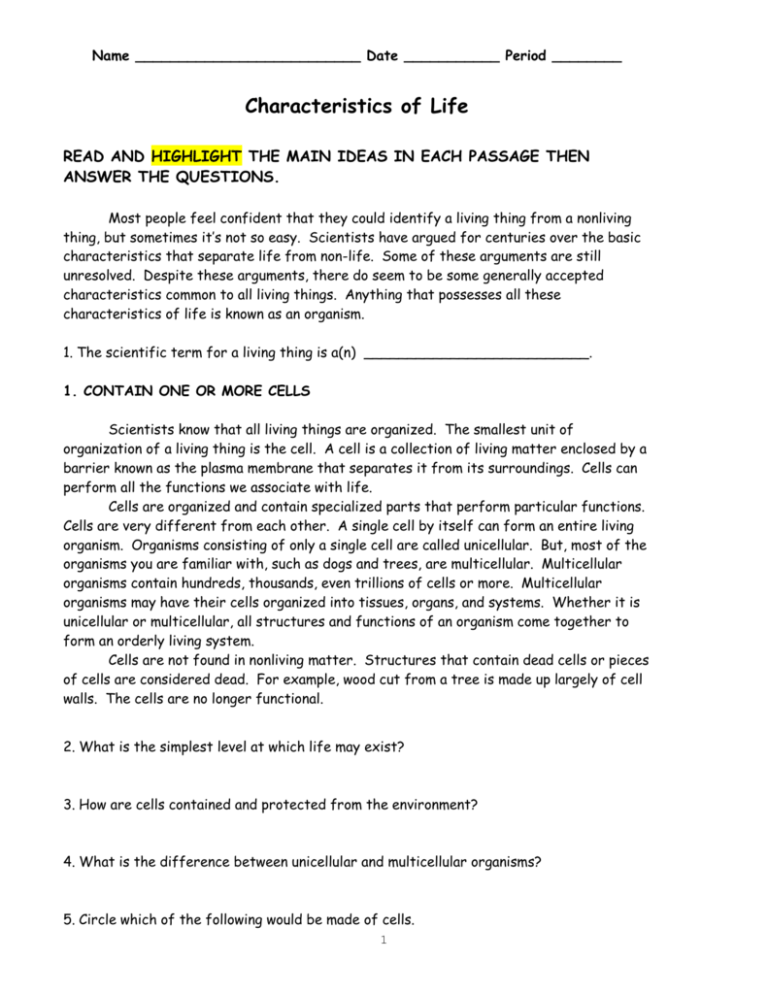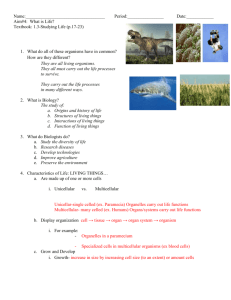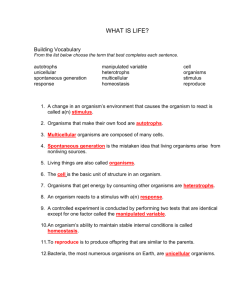1 1 characteristics of life packet
advertisement

Name __________________________ Date ___________ Period ________ Characteristics of Life READ AND HIGHLIGHT THE MAIN IDEAS IN EACH PASSAGE THEN ANSWER THE QUESTIONS. Most people feel confident that they could identify a living thing from a nonliving thing, but sometimes it’s not so easy. Scientists have argued for centuries over the basic characteristics that separate life from non-life. Some of these arguments are still unresolved. Despite these arguments, there do seem to be some generally accepted characteristics common to all living things. Anything that possesses all these characteristics of life is known as an organism. 1. The scientific term for a living thing is a(n) __________________________. 1. CONTAIN ONE OR MORE CELLS Scientists know that all living things are organized. The smallest unit of organization of a living thing is the cell. A cell is a collection of living matter enclosed by a barrier known as the plasma membrane that separates it from its surroundings. Cells can perform all the functions we associate with life. Cells are organized and contain specialized parts that perform particular functions. Cells are very different from each other. A single cell by itself can form an entire living organism. Organisms consisting of only a single cell are called unicellular. But, most of the organisms you are familiar with, such as dogs and trees, are multicellular. Multicellular organisms contain hundreds, thousands, even trillions of cells or more. Multicellular organisms may have their cells organized into tissues, organs, and systems. Whether it is unicellular or multicellular, all structures and functions of an organism come together to form an orderly living system. Cells are not found in nonliving matter. Structures that contain dead cells or pieces of cells are considered dead. For example, wood cut from a tree is made up largely of cell walls. The cells are no longer functional. 2. What is the simplest level at which life may exist? 3. How are cells contained and protected from the environment? 4. What is the difference between unicellular and multicellular organisms? 5. Circle which of the following would be made of cells. 1 Cork Sponge Wood Plastic Tree 6. Examine these 2 organisms. Which one is unicellular and which is multicellular (label each)? Dinoflagellate (magnified under a microscope) a fiddler crab 7. How are multicellular organisms organized? 2. REPRODUCTION Perhaps the most obvious of all the characteristics of life is reproduction, the production of offspring. Organisms don’t live forever. For life to continue, organisms must replace themselves. Reproduction is not essential for the survival of an individual organism. However, it is essential for the continuation of an organism’s species. A species is a group of similar-looking organisms that can interbreed and produce fertile offspring. If individuals in a species never reproduced, it would mean an end to that species’ existence on Earth. 8. Define reproduction. 9. Must EVERY member of a particular species (one kind of organism) be able to reproduce in order for the species to survive? Explain why or why not. 10. What would happen if all individuals in a species were sterile (not able to have babies)? 11. Reproduction is NOT essential for the survival of an individual ___________________ but is essential for the survival of the _______________________. 2 There are two basic kinds of reproduction: sexual and asexual. Sexual reproduction requires that two cells (sperm and egg) unite to produce the first cell of the new organism. Organisms reproducing sexually do not always have “sex!” In many cases sperm and egg are released into the water where they meet. Most familiar organisms – from maple trees to birds and bees – reproduce sexually. In asexual reproduction, a single organism can reproduce without the aid of another. Sometimes these organisms can just divide themselves in two! 12. Name and define the two basic kinds of reproduction. 13. Identify which organisms are reproducing sexually and which are reproducing asexually. BACTERIA HYDRA SEA URCHIN 3. GROWTH AND DEVELOPMENT Adults don’t always look like the babies of a species. All organisms begin their lives as single cells. Over time, these organisms grow and take on the characteristics of their species. Growth results in an increase in the amount of living material and the formation of new structures. All organisms grow, and different parts of organisms may grow at different rates. Organisms made up of only one cell may change little during their lives, but they do grow. On the other hand, organisms made up of numerous cells go through many changes during their lifetimes. Think about some of the structural changes your body has already undergone in your short life. All of the changes that take place during the life of an organism are known as its development. 14. What is the difference between growth and development? 3 15. Identify which graphic BEST shows growth and which BEST shows development. A snowball grows when you roll it over fresh snow! Why isn’t it a living thing? The growth of the snowball is not internal. Someone has to roll the snowball. It won’t grow bigger by just sitting there and it certainly cannot change liquid water or solid ice into new snow from which it can grow larger. This is one of the differences between growth of a living thing and growth of a nonliving thing. 16. How is the growth of a living thing different from the growth of a nonliving thing? 4. OBTAIN AND USE ENERGY Energy is the ability to make things change. Energy is important because it powers life processes. It provides organisms with the ability to maintain balance, grow, reproduce, and carry out other life functions. Some organisms obtain energy from the foods they eat or, in the case of plants and several other types of organisms, the foods that they produce. Organisms that get energy from the food they eat are called 4 heterotrophs. Organisms that use energy from the sun to make their own food (which they then use for energy) are called autotrophs. The process is called photosynthesis. As you’ll learn, energy doesn’t just flow through individual organisms; it also flows through communities of organisms, or ecosystems, and determines how organisms interact with each other and the environment. 17. Define energy. 18. Why is energy important to a living organism? 19. What is the difference between an autotroph and a heterotroph? 20. What is the name of the process that plants use to make their own food using energy from the sun? 21. Identify each of the organisms below as either a heterotroph or an autotroph. Green 5. RESPOND TO THE ENVIRONMENT / MAINTAIN HOMEOSTASIS Living things live in a constant connection with the environment, which includes the air, water, weather, temperature, any organisms in the area, and many other factors. These external environmental factors can change thereby causing a response from living things. Organisms need to respond to the changes in order to stay alive and healthy. For example, if you go outside on a bright summer day, the sun may cause you to squint. Perhaps the bark of an approaching dog causes you to turn your head quickly. Just as you 5 are constantly sensing and responding to changes in your environment, so are all other organisms. For example, a specialized leaf of the Venus’ flytrap senses the light footsteps of a soon-to-be-digested green bottle fly. The plant responded to this environmental stimulus by rapidly folding the leaf together. An organism must respond to changes in the internal environment as well. Internal conditions include the level of water, nutrients, and minerals inside the body. It also refers to body temperature and hormone levels. Adjustments to internal changes help organisms maintain a stable internal environment. The regulation of an organism’s internal environment to maintain conditions suitable for life is called homeostasis. Or you can just think of it as keeping everything in BALANCE! For example, you have a “thermostat” in your brain that reacts whenever your body temperature varies slightly from 37°C (about 98.6°F). If this internal thermostat detects a slight rise in your body temperature on a hot day, your brain signals your skin to produce sweat. Sweating helps cool your body. The ability of mammals and birds to regulate body temperature is just one example of homeostasis. Mechanisms of homeostasis enable organisms to regulate their internal environment, despite changes in their external environment. 22. Give two examples from the reading of how living things respond to changes in their external environment. 23. If light is applied to a human eye, how does it respond? 24. Describe homeostasis. Identify the feature of life that is illustrated by each of the following statements. NOTE: You may use terms other than the characteristics of life! 1. _______________________ “That boy shot up five inches in only one year.” 2. _______________________ “Our cat had a litter of kittens yesterday.” 3. _______________________ “My dog has become much less clumsy now that he is a year old.” 6 4. _______________________ “Eat a good breakfast and you will be able to run longer.” 5. _______________________ “When that car pulled in the driveway, my cat ran to hide under the porch.” 6. _______________________ “That owl’s night vision allows it to see the movement of mice on even the darkest night.” 7. _______________________ “Single-celled organisms live in the pond behind school.” 8. _______________________ Your body normally maintains a temperature of 98.6OF. 9. _______________________ A giraffe uses its long neck to eat from the high branches of a tree. 10. _______________________ is another name for “living thing.” 11. Which of the following is a stimulus, which is a response? a) the recess bell ringing in an elementary school b) your mouth watering at the sight of food on a plate c) a sudden drop in air temperature d) a flu virus entering your body e) getting “butterflies” in your stomach before giving a speech. 12. Determine if each of the following describes a living or nonliving thing. a) rust eating a hole in a metal bucket b) an apple on a tree c) bacteria d) lightning e) a dinosaur fossil f) a wasp * * * * * * * * 7 * * * * Biology is:= ____________________________________________________ Living Things are called:=____________________________________________ List Characteristics of ALL LIVING THINGS 1. ___________________________________ 2. ___________________________________ 3. ___________________________________ 4. ___________________________________ 5. ___________________________________ 6. ___________________________________ 7. ___________________________________ 8








